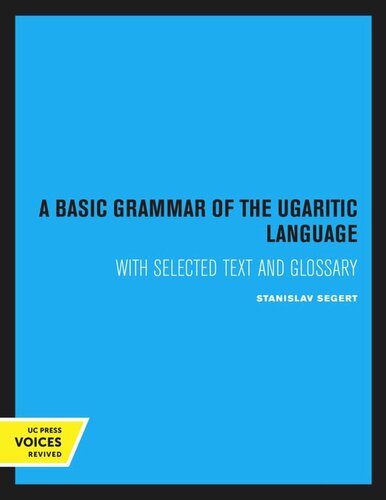(Ebook) A Basic Grammar of the Ugaritic Language: With Selected Text and Glossary by Stanislav Segert ISBN 9780520342101, 0520342100
In 1929, the first cuneiform tablet, inscribed with previously unknown signs, was found during archeological excavations at Ras Shamra (ancient Ugarit) in northern Syria. Since then a special discipline, sometimes called Ugaritology, has arisen. The impact of the Ugaritic language and of the many texts written in it has been felt in the study of Semitic languages and literatures, in the history of the ancient Near East, and especially in research devoted to the Hebrew Bible. In fact, knowledge of Ugaritic has become a standard prerequisite for the scientific study of the Old Testament. The Ugaritic texts, written in the fourteenth and thirteenth centuries B. c., represent the oldest complex of connected texts in any West Semitic language now available (1984). Their language is of critical importance for comparative Semitic linguistics and is uniquely important to the critical study of Biblical Hebrew. Ugaritic, which was spoken in a northwestern corner of the larger Canaanite linguistic area, cannot be considered a direct ancestor of Biblical Hebrew, but its conservative character can help in the reconstruction of the older stages of Hebrew phonology, word formation, and inflection. These systems were later-that is, during the period in which the biblical texts were actually written-complicated by phonological and other changes. The Ugaritic texts are remarkable, however, for more than just their antiquity and their linguistic witness. They present a remarkably vigorous and mature literature, one containing both epic cycles and shorter poems. The poetic structure of Ugaritic is noteworthy, among other reasons, for its use of the "parallelism of members" that also characterizes such ancient and archaizing poems in the Hebrew Bible as the Song of Deborah (in Judges 5), the Song of the Sea (in Exodus 15), Psalms 29, 68, and 82, and Habakkuk 3. Textual sources and their rendering The basic source for the study of Ugaritic is a corpus of texts written in an alphabetic cuneiform script unknown before 1929; this script represents consonants fully and exactly but gives only limited and equivocal indication of vowels. Our knowledge of the Ugaritic language is supple-mented by evidence from Akkadian texts found at Ugarit and containing many Ugaritic words, especially names written in the syllabic cuneiform script. Scholars reconstructing the lost language of Ugarit draw, finally, on a wide variety of comparative linguistic data, data from texts not found at Ugarit, as well as from living languages. Evidence from Phoenician, Hebrew, Amorite, Aramaic, Arabic, Akkadian, Ethiopic, and recently also Eblaitic, can be applied to good effect. For the student, as well as for the research scholar, it is important that the various sources of U garitic be distinguished in modern transliteration or transcription. Since many of the texts found at Ugarit are fragmentary or physically damaged, it is well for students to be clear about what portion of a text that they are reading actually survives and what portion is a modern attempt to fill in the blanks. While the selected texts in section 8 reflect the state of preservation in detail, in the other sections of the grammar standardized forms are presented, based on all available evidence.
*Free conversion of into popular formats such as PDF, DOCX, DOC, AZW, EPUB, and MOBI after payment.


